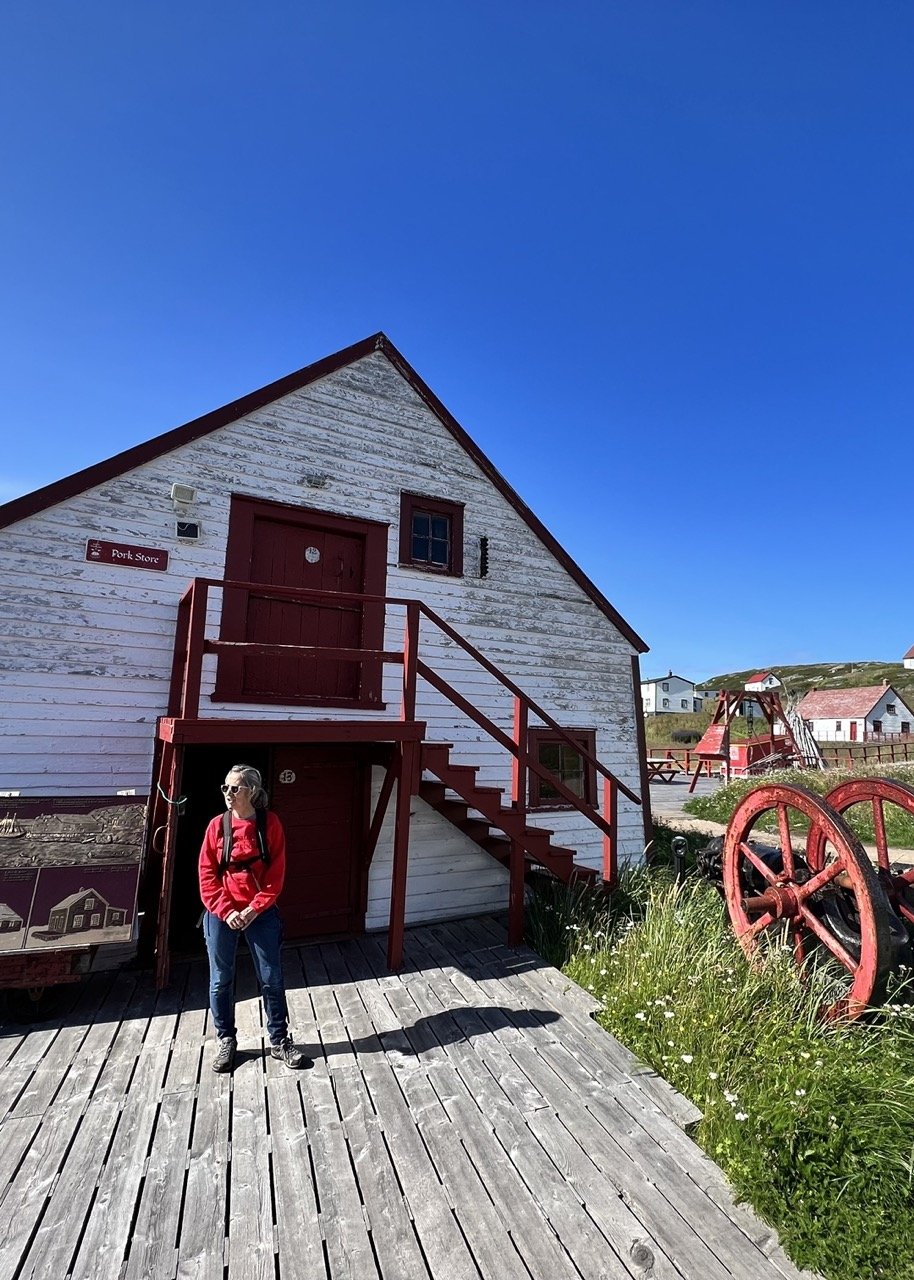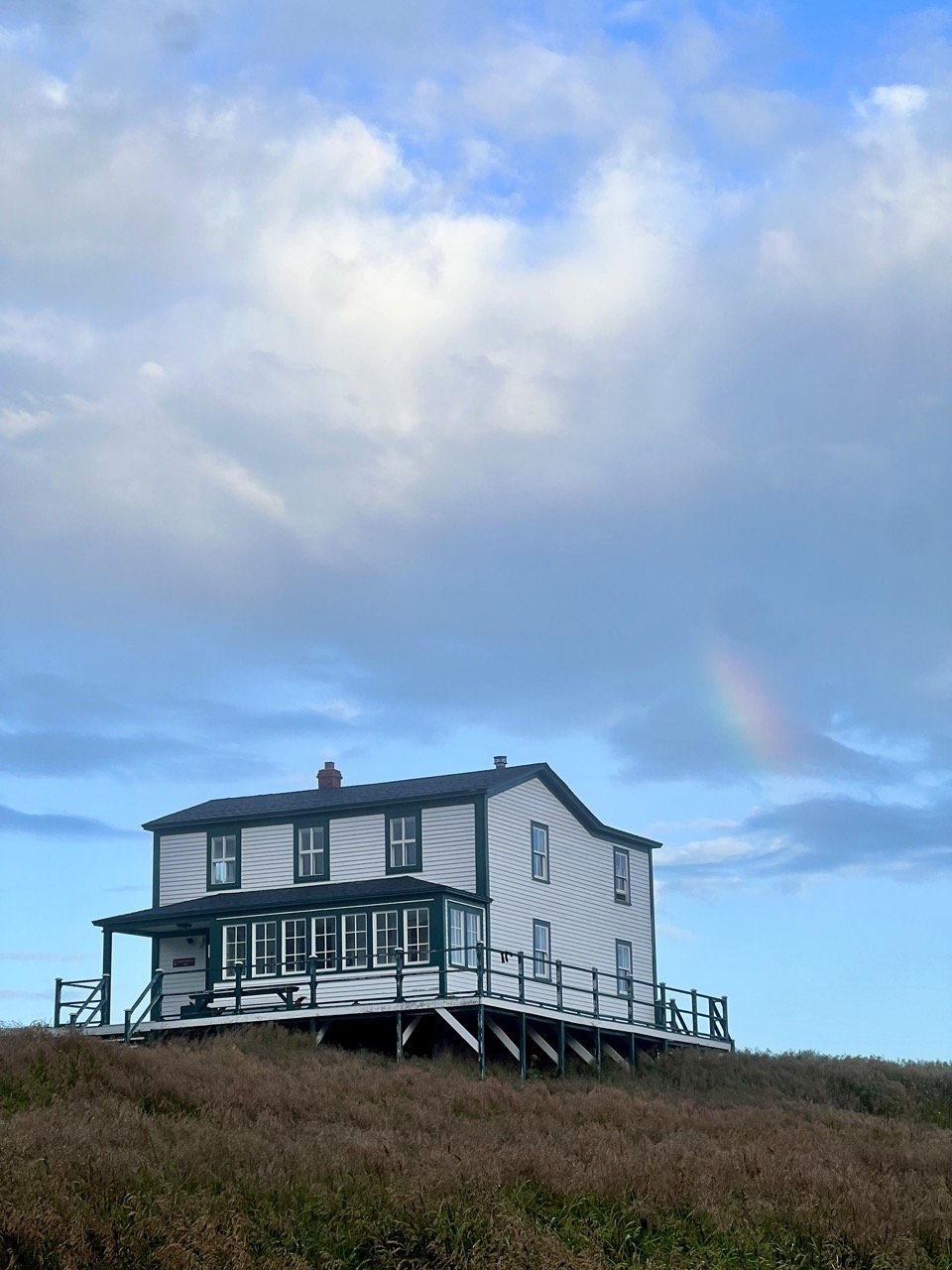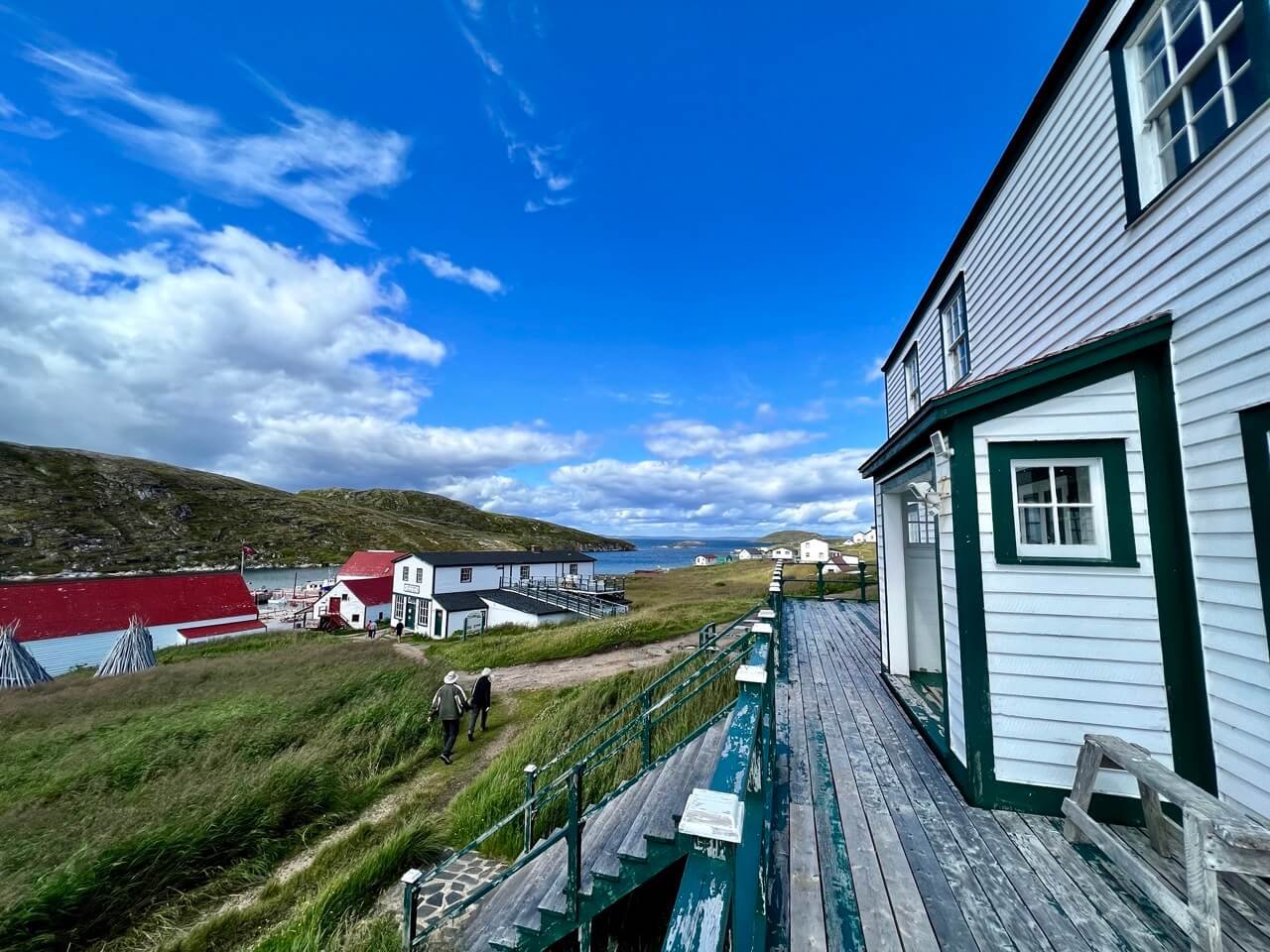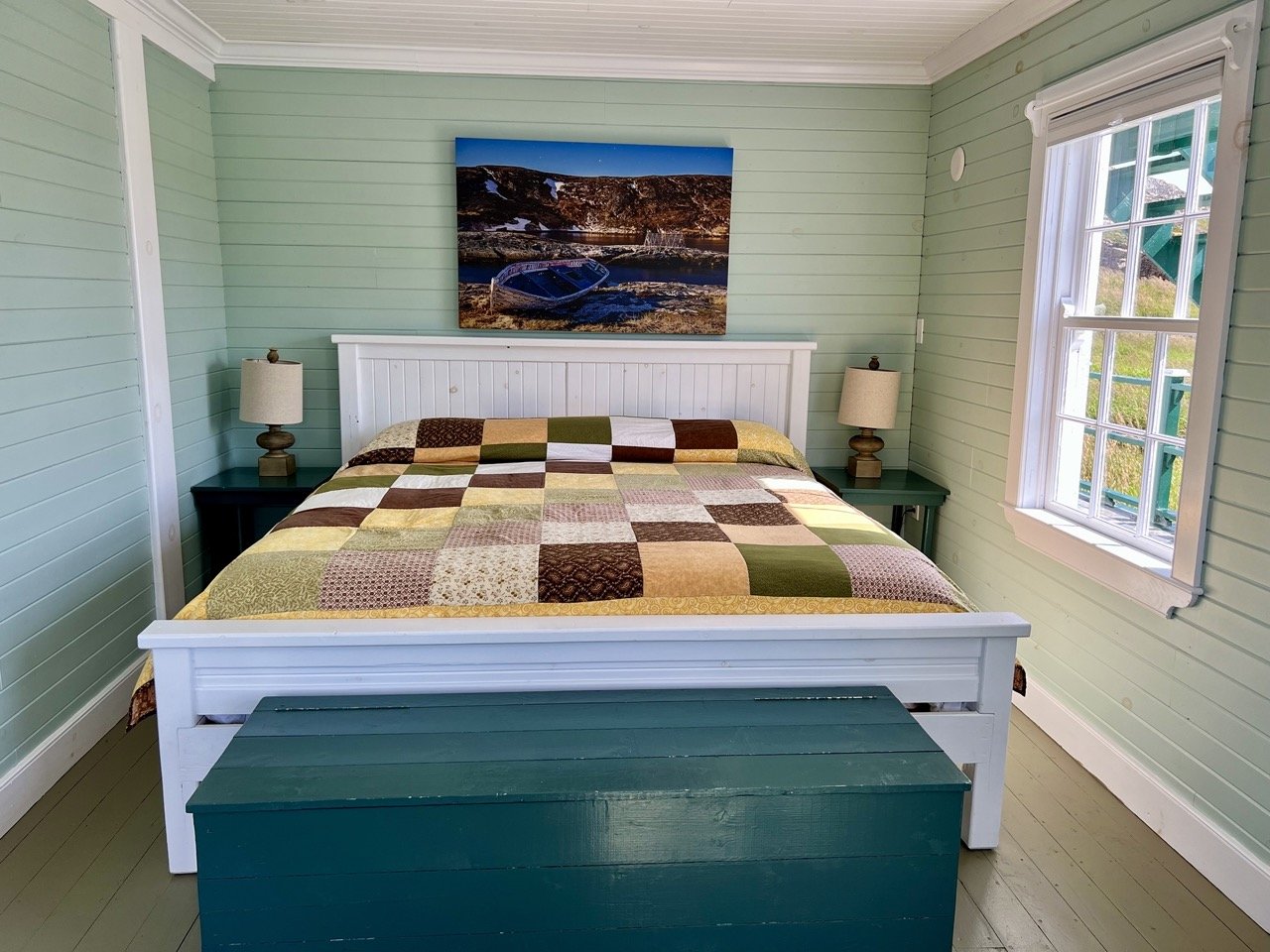Visiting the Living Museum of Battle Harbour: Step Back in Time for Perspective on the Present in Historic Labrador
Battle Harbour is an inspiring travel destination, located just off the Labrador Coast. Chris and I visited this island as Writers-in-Residence in Newfoundland & Labrador, and were prepared to immerse ourselves in its fishing history, but weren’t exactly ready for just how much this place and its people would move us.
The island of Battle Harbour, with Caribou Island in the distance.
Newfoundland and Labrador has been home to generations upon generations of innumerable fishing communities scattered across its seemingly endless shorelines and islands for hundreds of years. Despite so many of these communities having fallen by the wayside—whether being forced to relocate, being taken by Mother Nature and the sea, or just being left abandoned, these fishing towns, specifically its offshore ones, are an important yet often forgotten part of the province’s past.
For the curious traveller who is keen to understand not only the history of a destination, but the true sense of its place in the world, visiting the historic fishing village of Battle Harbour is a must. I consider myself lucky to have experienced many immersive and authentic travel experiences in the trips I’ve taken around the world, but I can honestly say that Battle Harbour holds its own as one of the most unique travel experiences I’ve taken part in.
Operated by the Battle Harbour Historic Trust, this destination ticks so many boxes when it comes to responsible travel in the 21st century. It makes use of all of the original buildings that have been here for hundreds of years, it welcomes small groups of travellers, capped at no more than 30 visitors to the island on any given night, and it’s locally operated by people whose ancestors have a longstanding history here.
If you are reading this and planning on travelling to Newfoundland & Labrador, then I’d highly recommend checking out more of our articles about experiences we had in the province, like taking a Ferryland picnic on the Irish Loop, attending the Writers at Woody Point Festival in Gros Morne, and lessons Chris learned after spending a month in the province.
A Brief History of Cod Fishing in Newfoundland & Labrador
Indigenous, Basque and European fishing communities flocked and fought over this coastline for one singular reason: cod. Cod was to fishing communities what gold was to prospectors—a livelihood, and a guaranteed source of sustenance for fishermen and their families from far and wide.
Long before it became a province in Canada, Newfoundland and Labrador’s small but mighty fishing communities were ingenuitive and self-sustaining. With little to no governance, they survived and thrived thanks to the abundance of food and a fair dose of hardship that the sea offered them.
Over the past century, significant changes have redefined the face of “The Rock”. Roads have been built, providing land access to many communities that were only accessible by boat for centuries. Other boat access communities have been forced to relocate, since their way of life and access to goods has been too remote for the province to support. And then, of course, the biggest shift of all: the Cod Moratorium of 1992; a day where nearly 500 years of cod fishing on the shores of Newfoundland and Labrador was brought to a hault in the blink of an eye.
Despite the reasons for the cod moratorium, it indelibly changed the face of the province and its fishing communities like Battle Harbour forever.
A fishing boat heading out to sea between the Battle islands.
Hundreds of Years of Battle Harbour
The start of Battle Harbour’s history began over 250 years ago, in the early 1770’s. It was a salt fish premises where fishermen could preserve and salt their catches. Despite its name, Battle Harbour’s heritage has nothing to do with a battle. Like so many places in Newfoundland and Labrador, it isn’t exactly clear how it got its name, but it’s thought that “battle” might derive from the Portuguese word for boat, “barco”.
By the early 1800s, several hundred schooners of fishermen from Newfoundland started to go “down north to the Labrador” from places like St. John’s, Conception Bay, Trinity Bay and Bonavista Bay in droves for the fishing season. As the permanent and temporary community on Battle Harbour grew, large buildings were built out from the wharf. This included salt stores, flour stores, a general store, cottages and rooming houses for fishermen and merchants. A church was also built in the mid-1800s.
Prior to the cod moratorium, Battle Harbour grew into a bustling community of around 300 permanent residents at its largest point. Thanks to many transient fishermen and their families who spent about half of the year on Battle Harbour, the number of people in the summer months was always significantly higher.
Many of the fishermen who settled on Battle Harbour for large parts of the year were from Carbonear, Newfoundland. This is true for Janice Hardy-Walsh, who was a friendly face and our tour guide on a walking tour around the island during our visit. Jan is a sixth generation resident of Battle Harbour. Her grandmother, Ethel Lewis, was born on the island. Her dad’s family was from Port Amour, down the coast of Labrador from Battle Harbour. Her mom’s family was from Nunatsiavut, an autonomous Inuit region up the coast of Labrador.
Jan remembers growing up in Carbonear and knowing that her siblings and her mom wouldn’t see her dad for many months out of the year unless they came to Battle Harbour, too. She spent twenty summers on Battle Harbour with her family, and even remembers starting school with the local students in some Septembers, before heading back home to Conception Bay for the winter. It wasn’t only her family that Jan spent her summers with on Battle Harbour. “These people are my friends,” she says of the residents of the island she grew up with, many of whom are still helping to run it today.
Jan is proud of her Labrador heritage. She spends her summers on Battle Harbour in her own modest cottage, sharing her knowledge, memories and deep connection with Battle Harbour with all who visit.
Jan Hardy-Walsh
“Materialistically, these people had nothing. But looking back, they had it all.”
Keeping History Alive at Battle Harbour Today
Visiting Battle Harbour today is as much about the opportunity to disconnect from the outside world as it is to connect with the people and the history of this restorative place.
Due to its remote nature and how long it takes to get here, day trips to Battle Harbour are possible through Battle Harbour Day Trips, but the best way to experience the full scope of this island is to stay overnight. In order to visit the island, you must stay for at least one night. The trip involves some dedication and anticipation, but is well worth the journey.
The Journey
Since Battle Harbour is only accessible by boat, you need to reach the mainland ferry to depart Battle Harbour first. Ferries depart daily at 11am from the Battle Harbour Ferry Terminal in Mary’s Harbour, Labrador.
Mary’s Harbour is a small town on the Labrador Coast, just off the Labrador Highway. In order to get here, you’ll need to drive. Chris and I rented a car during our month long trip through Newfoundland & Labrador, so we took the ferry from Saint Barbe, Newfoundland to Blanc-Sablon, Quebec before driving north through Port Amour, Red Bay, and eventually making our way up to Mary’s Harbour.
You’ll need to budget at least one night on each end of your time in Battle Harbour if you’re planning on catching the ferry to Newfoundland both ways. It’s also important to note that there are many stretches of the Labrador Highway that are remote, so making sure you have a full tank of gas is a must.
The Battle Harbour Ferry Terminal and modest ferry boat in Mary’s Harbour, Labrador.
Mary’s Harbour has a general store, Simms Cash & Carry, which is a good place to pick up any grocery items, sunscreen, bug repellant or anything else you might need before departing for Battle Harbour. Although the ferry leaves at 11, you’ll need to arrive between 10-10:30 to check in at the ferry terminal. Since your accommodation and visit to the island is all wrapped into one, your orientation to the island will take place at check-in, and you’ll be told where your room is on the island, and be provided with a brief overview and map of Battle Harbour.
The ferry to the Battle Harbour is a small boat that can take around 30 people, and takes about an hour from Mary’s Harbour. It’s a beautiful ride, weaving through tickles and islands as you make your way to this special corner of the Atlantic. Keep an eye out for playful seals, jumping fish, icebergs and even whale tails on the journey, since these are just the kind of calm waters and inlets they love to make themselves at home in.
Experiencing The Island
Approaching Battle Harbour feels like you’re being transported back to another place and time. Cottages of all shapes and colours are scattered on the sloping inlet in no particular order, and the protective hill over the harbour beckons brightly over the settlement.
Despite the large impact it has on all who visit, Battle Harbour itself is quite small: it’s only one kilometre long, and half a kilometre wide. As someone who loves to travel and do a lot on the road, knowing how small this place is felt really calming—there isn’t a lot that you “need” to do, but there are plenty of activities you can do if you feel so inclined. In the end, just being here is all part of the experience.
If you are so inclined, one of the activities available on the island is a two kilometre walking trail, with various stops and scenic viewpoints to stop at around the island. You can also take a boat across to neighbouring Caribou Island, which is a larger island and home to an equal amount of abandoned and thriving fishing cottages, as well as larger hiking paths.
For those looking to immerse themselves in the history and culture of the island, aside from taking the walking tour put on by one of the guides at Battle Harbour, there are also opportunities to go fishing, play the 170 year old pump organ inside the island’s church, or try your hand at bun making in the kitchen.
Visitors can take the scenic walking path that goes around the island on a visit to Battle Harbour.
On top of the General Store on the island, they also have a space known as “The Loft”, which is a cozy space that feels like a private pub, and is a wonderful place to sit and connect with other visitors at the end of a fulfilling day. They have wine and local beer available for purchase here as well, and visitors are encouraged to pick up an instrument and delight the group with a song or two, if they’re so inclined.
Regardless of what you plan to do on Battle Harbour, know that the weather will be unpredictable. You might not see the sun for a whole day. You may not be able to see your hand in front of you for the fog, and that’s okay. Stepping into this gratifying process of letting Mother Nature dictate what you can or can’t do is part of the process of living here.
And in the end, remember that you have the luxury of not being faced with needing to go out and fish for cod. You can simply take a moment to relax and turn the pages of your book as you let the fog roll out.
The Accommodations
The accommodations on Battle Harbour are the perfect balance of quaint, charming and updated. I know for a fact that the bed in our room was one of the comfiest I can recall sleeping in for the duration of the trip, and every detail in these tastefully updated rooms has been thought out perfectly.
There are several different buildings you can stay in on the island. The Merchant Building and the Battle Harbour Inn are larger buildings that have been divided into rooms to accommodate families and groups of all sizes. There are also several private cottages that you can rent on the island, each with their own living space and separate bedrooms. All of the buildings are heritage buildings that have been updated, while trying to keep as many of the original features in place as possible.
Chris and I stayed in the Slade Room in The Merchant Building. It is a stunning room with beautifully painted seafoam green floors and walls, and large, southwest facing windows lining wrapping around the room. The lounge chairs by the front bay windows are such a thoughtful touch in this cosy suite, and I spent quite a bit of time reading and looking out to views of the harbour below during my stay. The room has an ensuite bathroom too, making this suite quite spacious.
Dining
All meals are included during your stay on Battle Harbour. Meal times are at 8am, 12:30pm and 6pm, and all visitors to the island sit at large, family style tables in the dining hall. The meals typically consist of local, traditional Newfoundland & Labrador dishes, with fish, potatoes, fresh bread and homemade buns often playing a major role. We ate well during our time on Battle Harbour, and the seafood chowder was especially delicious.
The meal times are such a wonderful way to connect with fellow curious travellers at Battle Harbour. Everyone who comes to Battle Harbour has a story, whether it’s one about being from the province and always having wanted to come see it for themselves, or they’ve come from away and it’s been on their “bucket list” for quite some time. We enjoyed deep conversations with people from other parts of Canada, the United States and even fellow Torontonians on Battle Harbour. Some came for the history, some for the journey itself, and others just wanted to experience the beauty and mystery that is this island.
Leaning in to New Connections on Battle Harbour
To cap off a one-of-a-kind experience that was our trip to Battle Harbour, Chris and I even met Canadian musician Alan Doyle during our time here. He was visiting the island with his family on his way back from a show in Labrador City, and was so excited to be on Battle Harbour. He let us know he’s been trying to find the right time to visit it for so long. As a Newfoundlander, he felt so profoundly connected to a place he’d never been to before because of how important and significant its history is to the people of this province.
As everyone on the island, staff and visitors alike, were thrilled when Alan picked up his guitar to play to a room of about 20 of us in The Loft, Chris and I turned to each other and to our newfound friends to take a mental snapshot of how special this moment was. A Canadian and Newfoundland music icon singing to an intimate group of visitors to Battle Harbour and its staff, many of whom with several generations rooting them back to this place.
Peter Bull, Executive Director of Battle Harbour
“Your Cell Phone isn’t ringing. There are no cars, only paths. It’s just a place to step off and be.”
Embracing the Necessary Hardship and Beauty of Battle Harbour
On the day we arrived at Battle Harbour, a funeral was held for a beloved resident of Mary’s Harbour who lived well into her nineties. She was born on Battle Harbour, and brought back to the island and buried alongside her husband that day. On the tour of the island Jan Hardy-Walsh still decided to give us after the funeral, she poignantly shared that this woman was the person who taught her how to sew in those early summers on the island.
It’s this delicate balance of love and hardship that makes visiting Battle Harbour so moving. Meeting people like Jan who are firmly rooted in the island’s history and care so deeply about it is a touching reminder of the fullness of a life that comes from feeling so connected to a place and its people.
The people of Battle Harbour understand the necessary hardship of living in such a harsh but beautiful corner of the Atlantic. They know how much of Labrador’s labour intensive resources have been used by the country over the years, without always being given the same in return. They understand the consequences of the cod moratorium for the countless fishing communities like Battle Harbour, and they are dedicated to the cause of keeping the memory of these communities alive for generations to come.
And yet, despite all this, the people of Battle Harbour are some of the warmest and kindest people you’ll ever encounter. They are proud of their heritage and their ancestors, and are excited for the curious travellers who continue to feel the magic of happening upon the tickle of the harbour for the very first time.
They’ve known the secret of Battle Harbour for generations, and they’re honoured to share the life led by their ancestors with all who visit.
I want to humbly thank Newfoundland & Labrador Tourism for hosting Chris and me as media during this trip. All of the opinions expressed in this article are completely my own.













